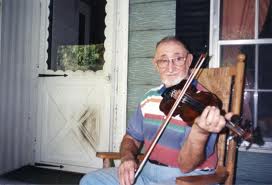Annotation:Sally Ann the Gal I Like: Difference between revisions
No edit summary |
No edit summary |
||
| (4 intermediate revisions by 2 users not shown) | |||
| Line 1: | Line 1: | ||
---------- | |||
{{TuneAnnotation | |||
|f_tune_annotation_title= https://tunearch.org/wiki/Annotation:Sally_Ann_the_Gal_I_Like > | |||
|f_annotation='''SALLY ANN, THE GAL I LIKE.''' AKA - "Little Sally Ann." AKA and see "[[Nancy Anne]]," "[[Possum up a Simmon Tree (1)]]." American, Reel (cut time). A Mixolydian/Major. Standard tuning or AEae (fiddle). AABB. The tune is from the repertory of Canada, Pike County, Kentucky, fiddler Owen "Snake" Chapman (1919-2002), who called the tune "Sally Ann, the Gal I Like" on a 1989 field recording made by collector and fiddler Bruce Greene. However, on Chapman's own recording, "Up in Chapman's Hollow" (named for the family settlement where they had been since the mid-19th century) the tune was called "[[Little Sally Ann]]." Chapman learned the reel from his father, a fiddler and practitioner of folk medicine named George "Doc" Chapman. The words Chapman remembered from his father's singing:[[File:chapman.jpg|400px|thumb|right|Owen "Snake" Chapman]] | |||
---- | |||
---- | |||
'''SALLY ANN, THE GAL I LIKE.''' AKA - "Little Sally Ann." AKA and see "[[Nancy Anne]]," "[[Possum up a Simmon Tree (1)]]." American, Reel (cut time). A Mixolydian/Major. Standard tuning (fiddle). AABB. The tune is from the repertory of Pike County, Kentucky, fiddler Owen "Snake" Chapman (1919-, who called the tune "Sally Ann, the Gal I Like" on a 1989 field recording made by collector and fiddler Bruce Greene. However, on Chapman's own recording, "Up in Chapman's Hollow" (named for the family settlement where they had been since the mid-19th century) the tune was called "[[Little Sally Ann]]." Chapman learned the reel from his father, a fiddler and practitioner of folk medicine named George "Doc" Chapman. The words Chapman remembered from his father's singing: | |||
<blockquote> | <blockquote> | ||
''Sally Ann’s the gal I like,''<br> | ''Sally Ann’s the gal I like,''<br> | ||
| Line 22: | Line 14: | ||
''And try to do the best you can.''<br> | ''And try to do the best you can.''<br> | ||
</blockquote> | </blockquote> | ||
See also the cognate tunes "[[Possum up a Simmon Tree (1)]],” from Kentucky fiddler Buddy Thomas, and Franklin George's “[[Nancy Anne]]." | See also the close cognate tunes "[[Possum up a Simmon Tree (1)]],” from northeastern Kentucky fiddler Buddy Thomas, and West Virginia fiddler Franklin George's “[[Nancy Anne]]." | ||
|f_source_for_notated_version= | |||
|f_printed_sources= | |||
|f_recorded_sources=Rounder Records 0378, Owen "Snake" Chapman – "Up in Chapman's Hollow" (1996). | |||
|f_see_also_listing=Hear Bruce Greene's 1989 field recording of Owen Champman playing the tune at Slippery Hill [https://www.slippery-hill.com/recording/sally-ann-gal-i] and on youtube.com [https://www.youtube.com/watch?v=YYsWWpRk81k]<br> | |||
}} | |||
------------- | |||
Hear Bruce Greene's 1989 field recording of Owen Champman playing the tune at Slippery Hill [https://www.slippery-hill.com/recording/sally-ann-gal-i] | |||
<br> | |||
---- | |||
Latest revision as of 00:07, 19 November 2020
X:1 T:Sally Ann, the Gal I Like S:Owen "Snake" Chapman M:C| L:1/8 D:Bruce Greene's 1989 field recording of Chapman Z:Transcribed by Andrew Kuntz K:Amix e4 e3e|e2f2g2 ag|f2d2 fded|BABc d2[d2f2]| e4 e3d|e2f2g2ag|fd2d fded|BA3 A4| [e3e3]f [e2e2]([d2e2][e2e2])-|[e2e2]f2g2ag|fd2d fded|BABc d2[d2f2]| [e3e3]f [e2e2]([d2e2][e2e2])-|[e2e2]f2g2ag|fd2d fded|BA3 A4|| |:efeA (BA)Ad|B2c2d2f2|efec A2cA|BA^GF E2E2| efec A2cA|B2c2d2e^g|f2d2 fded|BA3 A4:||

Sally Ann’s the gal I like,
We go to the ball and dance all night;
And just before the break of day,
She takes wings and flies away.
Fly around here little Sally Ann,
Fly around here little Sally Ann;
Fly around here little Sally Ann,
And try to do the best you can.
See also the close cognate tunes "Possum up a Simmon Tree (1),” from northeastern Kentucky fiddler Buddy Thomas, and West Virginia fiddler Franklin George's “Nancy Anne."

